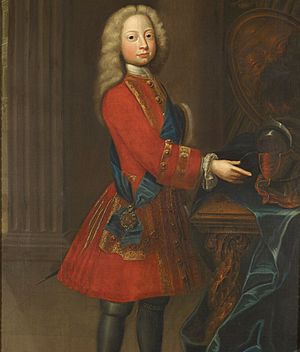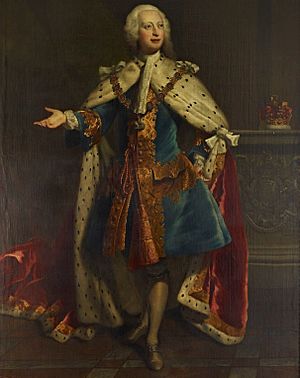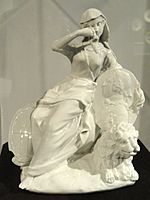Frederick, Prince of Wales facts for kids
Quick facts for kids Frederick |
|||||
|---|---|---|---|---|---|
| Prince of Wales | |||||
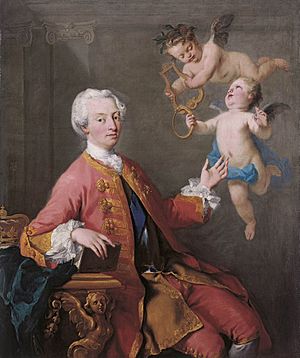
Portrait by Jacopo Amigoni, 1735
|
|||||
| Born | 31 January 1707 (New Style) Hanover, Holy Roman Empire (Germany) |
||||
| Died | 31 March 1751 (aged 44) Leicester House, London, England |
||||
| Burial | 13 April 1751 Westminster Abbey, London |
||||
| Spouse | |||||
| Issue |
|
||||
|
|||||
| House | Hanover | ||||
| Father | George II of Great Britain | ||||
| Mother | Caroline of Ansbach | ||||
Frederick, Prince of Wales KG (also known as Frederick Louis, German: Friedrich Ludwig; born 31 January 1707 – died 31 March 1751) was the oldest son of King George II of Great Britain. He was the next in line to the throne. Frederick didn't always get along well with his parents, King George and Queen Caroline. He was the father of King George III.
According to the Act of Settlement 1701, Frederick was fourth in line to the British throne when he was born. This was after his great-grandmother Sophia of Hanover, his grandfather George I of Great Britain, and his father, George. His grandfather became King of Great Britain in 1714. When his grandfather died and his father became king in 1727, Frederick moved to Great Britain. He was given the title Prince of Wales in 1729. However, Frederick died before his father. So, when his father passed away in 1760, the throne went to Frederick's oldest son, George III.
Contents
Early Life and Royal Connections
Prince Frederick Louis was born on 31 January 1707 in Hanover, which is now part of Germany. His parents were Caroline of Ansbach and Prince George. His grandfather, George, Elector of Hanover, was one of his godfathers. This grandfather was the son of Sophia of Hanover, who was a granddaughter of James VI and I.
Sophia was the heir to Queen Anne of Great Britain. However, Sophia died in June 1714, before Queen Anne. This made Frederick's grandfather, the Elector, the next in line. Queen Anne died on 1 August of the same year, and Sophia's son became King George I. This meant Frederick's father was now first in line to the British throne, and Frederick himself was second. Frederick's other godfather was his great-uncle Frederick I of Prussia. Frederick was sometimes called "Griff" by his family.
When Frederick was seven years old, his parents had to leave Hanover to go to Great Britain. He was left in the care of his great-uncle Ernest Augustus, Duke of York and Albany. Frederick did not see his parents again for 14 years.
In 1722, Frederick was given a smallpox vaccine by a doctor named Charles Maitland. This was done on his mother Caroline's orders. His grandfather, King George I, gave him several titles on 26 July 1726. These included Duke of Edinburgh and Earl of Eltham.
Frederick arrived in Great Britain in 1728, a year after his father became King George II. By this time, his parents had several younger children. Frederick, now the Prince of Wales, was a lively young man. The long time apart had made his relationship with his parents difficult, and they never became very close. Many places were named after him, including Fredericksburg, Virginia, and Fort Frederica, Georgia.
Becoming Prince of Wales
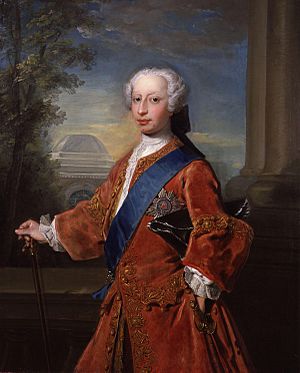
Frederick was made Prince of Wales on 7 January 1728. He also served as the tenth leader of the University of Dublin from 1728 to 1751. His portrait is still proudly displayed in the Hall of Trinity College Dublin.
Once he was living in London, Frederick started to support politicians who were against his father's government. He also supported the Opera of the Nobility. This opera company was a rival to George Frideric Handel's opera, which was supported by the King. Frederick loved music and played the viola and cello. He is shown playing a cello in several paintings with his sisters. He was also interested in science and art.
According to court gossip, Frederick often disagreed with his parents. The King and Queen preferred Frederick's younger brother, Prince William, Duke of Cumberland. The King even thought about splitting his lands so that Frederick would only inherit Britain, while William would get Hanover.
Frederick and a friend, Lord Hervey, wrote a play together. It was performed in October 1731 but was not popular with critics or the audience.
Supporting the Arts
One lasting result of Frederick's support for the arts is "Rule, Britannia!" This is one of Britain's most famous patriotic songs. It was written by the English composer Thomas Arne with words by the Scottish poet James Thomson. It was first performed on 1 August 1740. Thomas Arne was one of Frederick's favorite artists. The song connected the prince with the Saxon hero-king Alfred the Great and with the idea of building up British sea power. This fit well with Frederick's plans. The song later became very popular on its own.
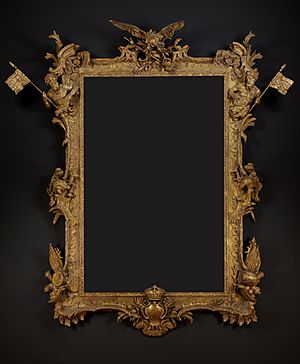
Frederick was also very knowledgeable about painting. He supported artists who came from other countries, like Jacopo Amigoni and Jean-Baptiste van Loo. These artists painted portraits of the prince and his wife. He also supported other important English artists of the time.
The prince was very important in making the Rococo style popular in decorative arts. He preferred French craftsmen. He supported silversmiths and carvers, like Paul Petit. Petit made magnificent frames in the Rococo style for Frederick. One frame, made in 1748 for his cousin Frederick the Great, was very grand. It showed how much the prince admired his cousin. This suggested that Frederick identified with Frederick the Great's style of leadership, rather than his own father's.
Most of Frederick's homes in London have been torn down. Only his country home, Cliveden, still stands, though it has been changed a lot over time.
Family Life
Frederick almost married Wilhelmine, the daughter of his father's cousin, Frederick William I of Prussia. Frederick liked the idea, even though they had never met. His father, King George II, wasn't very keen on the marriage but kept talking about it for diplomatic reasons. Frederick, tired of waiting, sent his own messenger to the Prussian court. When King George II found out, he quickly arranged for Frederick to leave Hanover for England. The marriage talks ended when Frederick William demanded that Frederick be made the ruler in Hanover.
Frederick also nearly married Lady Diana Spencer. She was the favorite granddaughter of the powerful Sarah, Duchess of Marlborough. The Duchess wanted a royal connection for her family. She offered a huge amount of money, £100,000, if Lady Diana married the Prince of Wales. Frederick, who was in debt, agreed. However, the plan was stopped by the King and his chief minister, Robert Walpole. Lady Diana soon married John Russell, 4th Duke of Bedford.
Although he had a lively social life when he was younger, Frederick settled down after marrying Princess Augusta of Saxe-Gotha. She was sixteen years old when they married on 27 April 1736. The wedding took place at the Chapel Royal at St James's Palace. The composer Handel wrote a new song for the service.
In May 1736, King George II went back to Hanover. This made him unpopular in England. People even put up a joking sign at St James's Palace, saying he had "lost or strayed" from his family. The King eventually returned to England in January 1737. He became ill, and Frederick spread rumors that the King was dying. To prove the rumors wrong, George insisted on getting up and attending a social event.
Frederick often had large debts and relied on his wealthy friend George Bubb Dodington for money. His father refused to give him as much money as Frederick thought he should have. Frederick continued to openly disagree with his father's government. He spoke against unpopular laws, like the Gin Act 1736, which tried to control the widespread drinking of gin. Frederick asked Parliament for more money, and this public disagreement further strained his relationship with his parents. His allowance was increased, but not by as much as he wanted.
In June 1737, Frederick told his parents that Augusta was expecting a baby in October. However, Augusta's due date was earlier. In July, when Frederick found out his wife was in labor, he secretly took her out of Hampton Court Palace in the middle of the night. He wanted to make sure the King and Queen could not be present at the birth. George and Caroline were very upset. The Queen rushed to St James's Palace, where Frederick had taken Augusta. Caroline was relieved to find that Augusta had given birth to a small baby girl. The way the birth happened made the relationship between mother and son even worse.
Frederick was banned from the King's court. He set up his own rival court at Leicester House. His mother became very ill later that year, but the King would not let Frederick see her. Frederick became a devoted family man. He took his wife and children to live in the countryside at Cliveden, where he enjoyed fishing and other outdoor activities. In 1742, Robert Walpole left his government position. This change led to a better relationship between Frederick and his father.
After the Jacobite rising of 1745, Frederick met Flora MacDonald, who had been jailed for helping the leader of the uprising, Charles Edward Stuart, escape. Frederick helped her to be released. In 1747, Frederick again joined the political opposition. The King responded by dissolving Parliament. In the election that followed, Frederick's political friends lost.
Frederick's Love for Cricket
When Frederick arrived in Great Britain, cricket was already the country's most popular team sport. People loved to bet on it. Perhaps to fit in with English society, Frederick became very interested in cricket. He soon became a true fan. He started betting on games and then began to support and play the sport. He even formed his own team a few times.
The first time Frederick is mentioned in cricket records is in a report from 28 September 1731. This was about a match between Surrey and London. The game was played on Kennington Common. The report mentioned that the playing area was "staked and roped out" for the players. This was a new practice in 1731 and might have been done because a royal visitor was expected. The advertisement for the game said that the Prince of Wales was "expected to attend."
In August 1732, a newspaper reported that Frederick watched "a great cricket match" at Kew on 27 July.
By 1733, Frederick was very involved in the game. He was like a county cricketer for Surrey. He was said to have given money to each player in a game between Surrey and Middlesex. Then he gave a silver cup to a combined Surrey and Middlesex team. This team had just beaten Kent, which was one of the best teams at the time. This was the first time a trophy (other than money) was given in cricket history. On 31 August, the Prince of Wales's team played against another team. The result is not known, but the teams were considered to be of a high standard.
In the years after 1733, Frederick was often mentioned as someone who supported cricket and sometimes played it.
When he died on 31 March 1751, cricket lost an important supporter. This was a big blow to the sport, as another major supporter had also died recently. The number of top-level matches decreased for several years.
Death
Frederick died at Leicester House at the age of 44 on 31 March 1751. His political goals were not fully achieved. In the past, people thought he died from a burst lung due to being hit by a cricket or tennis ball. However, it is now believed he died from a sudden illness. He was buried at Westminster Abbey on 13 April 1751. Frederick is the most recent Prince of Wales who did not become the British king.
A famous poem was written about his death:
"Here lies poor Fred who was alive and is dead,
Had it been his father I had much rather,
Had it been his sister nobody would have missed her,
Had it been his brother, still better than another,
Had it been the whole generation, so much better for the nation,
But since it is Fred who was alive and is dead,
There is no more to be said!"
Titles, Honours, and Royal Symbols
British Titles
Frederick was given the title Duke of Gloucester on 10 January 1717. When he was made a peer (a high-ranking noble) on 26 July 1726, he became the Duke of Edinburgh. He became Duke of Cornwall on 11 June 1727 and Prince of Wales on 7 January 1729.
Honours
- 3 July 1717: Royal Knight of the Garter
Arms
From 1726, when he became Duke of Edinburgh, until he became Prince of Wales, he used the royal coat of arms. It had a special white stripe with three points, and the middle point had a red cross. As Prince of Wales, the special mark changed to just a white stripe with three points. Frederick never became the Treasurer of the Holy Roman Empire like his father, so the red shield in the middle of his Hanover quarter was empty.
| Arms of Frederick, Prince of Wales |
Family
Ancestors
| Ancestors of Frederick, Prince of Wales | |||||||||||||||||||||||||||||||||||||||||||||||||||||||||||||||||||||||||||||||||||||||||||||||||||||||||||||||||||||||||||||||||||||||||||||||||||||||||||||||||||||||||||||||||||||||||||||||||||||||||||||||||||||||||||||||||||||||||||||||||||||||||||||||||||||||||||||||||||||||||
|---|---|---|---|---|---|---|---|---|---|---|---|---|---|---|---|---|---|---|---|---|---|---|---|---|---|---|---|---|---|---|---|---|---|---|---|---|---|---|---|---|---|---|---|---|---|---|---|---|---|---|---|---|---|---|---|---|---|---|---|---|---|---|---|---|---|---|---|---|---|---|---|---|---|---|---|---|---|---|---|---|---|---|---|---|---|---|---|---|---|---|---|---|---|---|---|---|---|---|---|---|---|---|---|---|---|---|---|---|---|---|---|---|---|---|---|---|---|---|---|---|---|---|---|---|---|---|---|---|---|---|---|---|---|---|---|---|---|---|---|---|---|---|---|---|---|---|---|---|---|---|---|---|---|---|---|---|---|---|---|---|---|---|---|---|---|---|---|---|---|---|---|---|---|---|---|---|---|---|---|---|---|---|---|---|---|---|---|---|---|---|---|---|---|---|---|---|---|---|---|---|---|---|---|---|---|---|---|---|---|---|---|---|---|---|---|---|---|---|---|---|---|---|---|---|---|---|---|---|---|---|---|---|---|---|---|---|---|---|---|---|---|---|---|---|---|---|---|---|---|---|---|---|---|---|---|---|---|---|---|---|---|---|---|---|---|---|---|---|---|---|---|---|---|---|---|---|---|---|---|---|---|
|
|||||||||||||||||||||||||||||||||||||||||||||||||||||||||||||||||||||||||||||||||||||||||||||||||||||||||||||||||||||||||||||||||||||||||||||||||||||||||||||||||||||||||||||||||||||||||||||||||||||||||||||||||||||||||||||||||||||||||||||||||||||||||||||||||||||||||||||||||||||||||
Children with Princess Augusta of Saxe-Gotha
| Name | Birth | Death | Notes |
|---|---|---|---|
| Princess Augusta | 31 July 1737 | 23 March 1813 | Married Charles William Ferdinand, Duke of Brunswick-Wolfenbüttel in 1764; they had children. |
| George III | 4 June 1738 | 29 January 1820 | Married Charlotte of Mecklenburg-Strelitz in 1761; they had children. |
| Prince Edward, Duke of York and Albany | 25 March 1739 | 17 September 1767 | Died at age twenty-eight, never married. |
| Princess Elizabeth | 10 January 1741 | 4 September 1759 | Died at age eighteen, never married. |
| Prince William Henry, Duke of Gloucester and Edinburgh | 25 November 1743 | 25 August 1805 | Married Maria Waldegrave in 1766; they had children. |
| Prince Henry, Duke of Cumberland and Strathearn | 7 November 1745 | 18 September 1790 | Married Anne Horton in 1771; they had no children. |
| Princess Louisa | 19 March 1749 | 13 May 1768 | Died at age nineteen, never married. |
| Prince Frederick | 13 May 1750 | 29 December 1765 | Died at age fifteen, never married. |
| Princess Caroline Matilda | 11 July 1751 | 10 May 1775 | Born after Frederick's death; married Christian VII of Denmark and Norway in 1766; they had children. |
See also
 In Spanish: Federico Luis de Gales para niños
In Spanish: Federico Luis de Gales para niños


